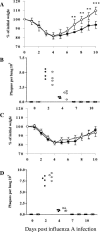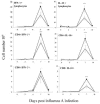Amelioration of influenza-induced pathology in mice by coinfection with Trichinella spiralis
- PMID: 16495568
- PMCID: PMC1418664
- DOI: 10.1128/IAI.74.3.1924-1932.2006
Amelioration of influenza-induced pathology in mice by coinfection with Trichinella spiralis
Abstract
Illness due to respiratory virus infection is often induced by excessive infiltration of cells into pulmonary tissues, leading to airway occlusion. We show here that infection with Trichinella spiralis results in lower levels of tumor necrosis factor in bronchoalveolar lavage fluid and inhibits cellular recruitment into the airways of mice coinfected with influenza A virus. Infiltration of neutrophils and CD4+ and CD8+ lymphocytes was reduced, resulting in animals gaining weight more rapidly following the initial phase of infection. Influenza resulted in a generalized increase in vascular permeability in pulmonary tissues, and this was suppressed by parasite infection, although the effects were restricted to the early phase of trichinosis. Moreover, the number of cells producing interleukin-10 (IL-10), and the local levels of this cytokine, were reduced, suggesting that amelioration of pulmonary pathology by parasite infection occurs independently of IL-10 production.
Figures









Similar articles
-
Trichinella as a modulator of flu-induced pathology?Trends Parasitol. 2006 Oct;22(10):452-4. doi: 10.1016/j.pt.2006.08.004. Epub 2006 Aug 21. Trends Parasitol. 2006. PMID: 16920026 Review.
-
Induction of the IL-10-producing regulatory B cell phenotype following Trichinella spiralis infection.Mol Immunol. 2021 May;133:86-94. doi: 10.1016/j.molimm.2021.02.012. Epub 2021 Feb 23. Mol Immunol. 2021. PMID: 33636433
-
Trichinella spiralis: infection reduces airway allergic inflammation in mice.Exp Parasitol. 2011 Feb;127(2):539-44. doi: 10.1016/j.exppara.2010.10.004. Epub 2010 Oct 30. Exp Parasitol. 2011. PMID: 21044628
-
Coinfection with Clonorchis sinensis modulates murine host response against Trichinella spiralis infection.Parasitol Res. 2013 Sep;112(9):3167-79. doi: 10.1007/s00436-013-3493-1. Epub 2013 Jul 12. Parasitol Res. 2013. PMID: 23846239
-
Immunity to Trichinella spiralis muscle infection.Vet Parasitol. 2009 Feb 23;159(3-4):245-8. doi: 10.1016/j.vetpar.2008.10.051. Epub 2008 Oct 22. Vet Parasitol. 2009. PMID: 19070961 Free PMC article. Review.
Cited by
-
The New Status of Parasitic Diseases in the COVID-19 Pandemic-Risk Factors or Protective Agents?J Clin Med. 2021 Jun 7;10(11):2533. doi: 10.3390/jcm10112533. J Clin Med. 2021. PMID: 34200502 Free PMC article. Review.
-
Plasmodium chabaudi limits early Nippostrongylus brasiliensis-induced pulmonary immune activation and Th2 polarization in co-infected mice.BMC Immunol. 2009 Dec 1;10:60. doi: 10.1186/1471-2172-10-60. BMC Immunol. 2009. PMID: 19951425 Free PMC article.
-
Helminth exposure protects against murine SARS-CoV-2 infection through macrophage dependent T cell activation.bioRxiv [Preprint]. 2022 Nov 10:2022.11.09.515832. doi: 10.1101/2022.11.09.515832. bioRxiv. 2022. Update in: Sci Immunol. 2023 Aug 18;8(86):eadf8161. doi: 10.1126/sciimmunol.adf8161. PMID: 36380767 Free PMC article. Updated. Preprint.
-
Effects of parasites coinfection with other pathogens on animal host: A literature review.Vet World. 2022 Oct;15(10):2414-2424. doi: 10.14202/vetworld.2022.2414-2424. Epub 2022 Oct 15. Vet World. 2022. PMID: 36425132 Free PMC article. Review.
-
Infection against infection: parasite antagonism against parasites, viruses and bacteria.Infect Dis Poverty. 2019 Jun 15;8(1):49. doi: 10.1186/s40249-019-0560-6. Infect Dis Poverty. 2019. PMID: 31200765 Free PMC article. Review.
References
-
- Bany, J., M. K. Janiak, and W. Budzynski. 1992. Activity of natural killer (NK) cells in the course of experimental trichinellosis in mice. Wiad. Parazytol. 38:117-126. - PubMed
-
- Biron, C. A., and L. Brossay. 2001. NK cells and NKT cells in innate defense against viral infections. Curr. Opin. Immunol. 13:458-464. - PubMed
-
- Bliss, S. K., A. Alcaraz, and J. A. Appleton. 2003. IL-10 prevents liver necrosis during murine infection with Trichinella spiralis. J. Immunol. 171:3142-3147. - PubMed
Publication types
MeSH terms
Substances
Grants and funding
LinkOut - more resources
Full Text Sources
Research Materials

